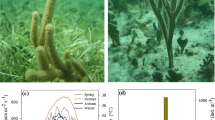Abstract
Seasonal variations and the effect of reproductive development on resource acquisition by two intertidal fucoid species, the iteroparous Fucus serratus L. and the semelparous Himanthalia elongata (L.) S. F. Gray were examined. The oxygen-exchange characteristics of vegetative apical tissue of both non-fertile and fertile plants and receptacle tissue were compared at monthly intervals throughout reproductive development. Respiratory rates in non-fertile F. serratus varied seasonally between 1.5 and 8.0 μmol g−1 fresh wt h−1; in fertile plants the receptacle had a significantly lower respiratory rate than the vegetative tissue. The respiratory rate of the vegetative button of fertile H. elongata displayed less seasonal variation and was lower than that of the receptacle, which varied from a maximum of 9.5 μmol g−1 fresh wt h−1 at receptacle initiation in October to a minimum of 2.0 μmol g−1 fresh wt h−1 in February. The maximum photosynthetic rate (P max) of non-fertile plants of both species did not vary in a distinct seasonal manner (∼60 μmol g−1 fresh wt h−1 for F. serratus and ∼12 μmol g−1 fresh wt h−1 for H. elongata). In fertile plants, the P max of the receptacle tissue was (∼50% lower in F. serratus, and at its peak three times higher in H. elongata, than that of vegetative tissue. The stable carbon-isotope ratio (δ13C) did not differ between different tissue types in F. serratus, but values did vary seasonally, being less negative in the summer than in the winter (−13.5‰ compared to −18‰). The receptacle tissue of H. elongata also displayed a distinct seasonal variation in δ13C values (−12‰ in summer, −16‰ in winter), whilst the δ13C of the vegetative button did not vary seasonally. The rate of uptake of inorganic nitrogen by the vegetative thallus was lower in H. elongata than in F. serratus. The receptacle tissue of F. serratus had lower uptake rates than the vegetative tissue, whilst the uptake rate by H. elongata receptacle tissue was higher than that of the vegetative button.
Similar content being viewed by others
Author information
Authors and Affiliations
Additional information
Received: 14 March 1997 / Accepted: 22 April 1997
Rights and permissions
About this article
Cite this article
Brenchley, J., Raven, J. & Johnston, A. Resource acquisition in two intertidal fucoid seaweeds, Fucus serratus and Himanthalia elongata : seasonal variation and effects of reproductive development. Marine Biology 129, 367–375 (1997). https://doi.org/10.1007/s002270050177
Issue Date:
DOI: https://doi.org/10.1007/s002270050177




